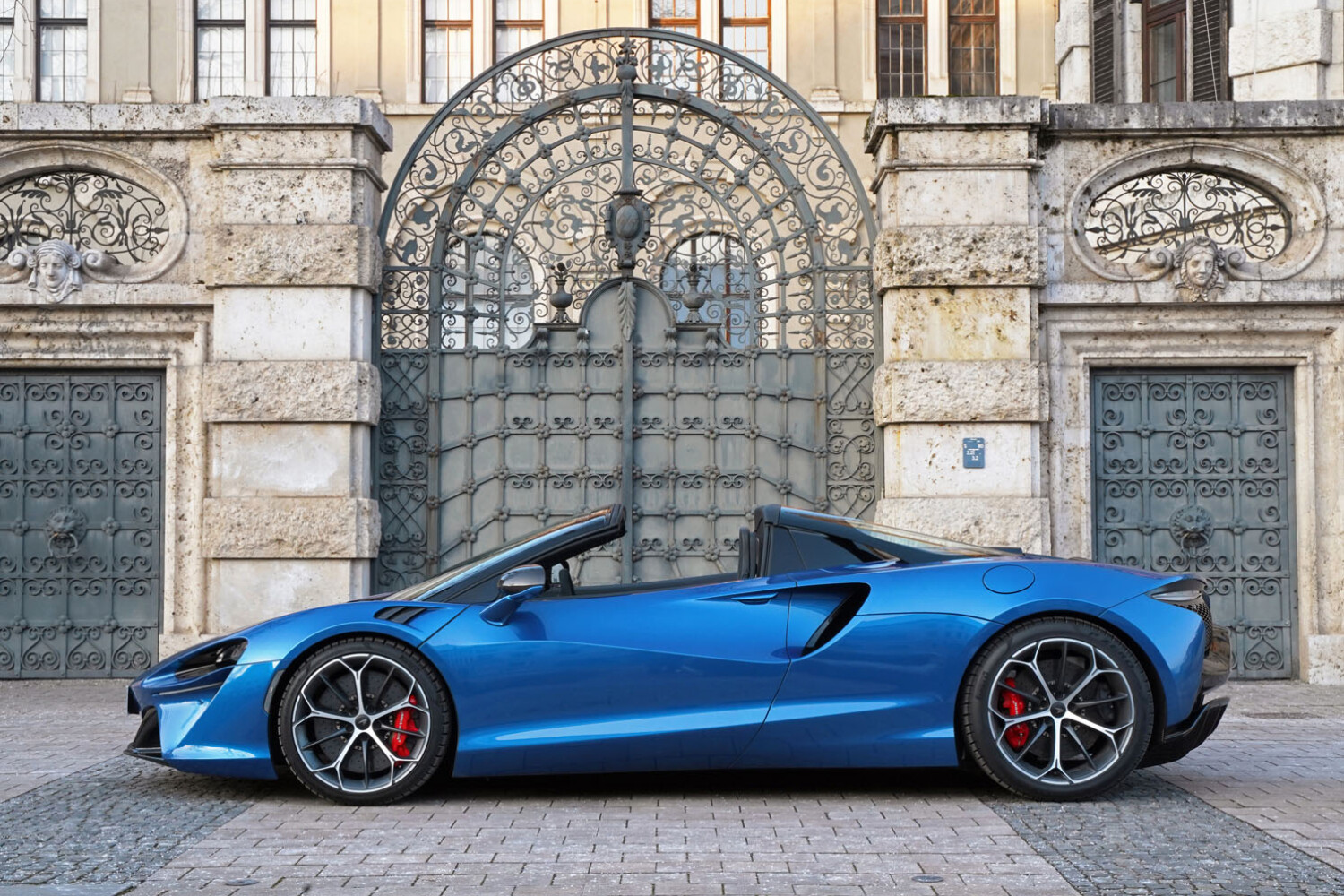Munich | Bavaria – The McLaren Artura Spider is the British car manufacturer’s first hybrid convertible. Thanks to extensive setup options, the 700 hp supercar offers ultimate racing performance and also enough comfort for everyday use. I had the opportunity to test the plug-in hybrid sports car in snowy Upper Bavaria, Germany …
700 hp with an unladen weight of just 1,560 kilograms (3,439 lbs) are impressive figures even for a supercar. The McLaren Artura Spider, hand-built in Woking in the UK, is also the sports car manufacturer’s first hybrid convertible. As such, I had been eagerly anticipating this extraordinary test drive. Having made arrangements with the McLaren Automotive headquarters a few months earlier, I was able to pick up the sports car – with all its Formula 1 genes – from McLaren Munich for a multi-day test. As a high-performance plug-in hybrid, the drivetrain of the McLaren Artura Spider has an electric motor in addition to the petrol engine, which not only provides additional performance, but also enables purely electric driving for up to 33 kilometres (20.5 miles).
MCLAREN ARTURA SPIDER – COUPÉ AND CONVERTIBLE IN ONE
With the roof closed, the McLaren Artura Spider looks almost indistinguishable from a coupé. The engineers and designers, located in the western part of the county of Surrey, have succeeded very well in harmoniously integrating the hardtop into the silhouette of the supercar. The additional weight compared to the Artura Coupé is only 62 kilograms (137 lbs), which is mainly due to the electric-powered roof construction. No fewer than eight electric motors ensure that the hardtop opens almost silently in just 11 seconds, transforming the coupé into a convertible. The roof can be opened and closed at speeds of up to 50 km/h (31 mph).
Like in Formula 1, the carbon fibre monocoque makes the passenger compartment very safe and offers full body rigidity even when the roof is open. The lightweight platform, used for the first time in the McLaren Artura, is supplemented by a front impact structure and a rear frame – both made of aluminum. The most striking changes compared to the coupé are the roof structure and the struts made of transparent polycarbonate behind it, which ensure optimised airflow and better all-round visibility. Also new are the two air intakes on the rear part of the engine cover.
During my first test drive through Munich, I stopped at the Bavarian National Museum on Prinzregentenstrasse to take a closer look at the McLaren Artura Spider from the outside. At first glance, the car is immediately recognizable as a McLaren. Both the bold front and the open rear, complete with ventilation grilles, speak for themselves. The Volcano Blue color suits the British supercar perfectly and gives it an elegant look. Those wishing to show their passion for racing on the outside can opt for the classic “McLaren Orange”. In total, there are over 40 exterior colors to choose from.
ULTIMATE EXCITEMENT – WITH OR WITHOUT ENGINE SOUND
After starting up, the McLaren Artura Spider automatically goes into the electric drive mode. I roll out of the underground parking garage at Motorworld Munich almost silently, accompanied only by a quiet whirring. After a cold start, the V6 petrol engine only delivers drive power once it has warmed up the catalytic converters. However, this short delay is hardly noticeable in practice. At the start, I cruise through Munich towards Garmisch-Partenkirchen on electric power alone. Once the battery is empty, I switch to Comfort mode, and the petrol engine switches off periodically when the battery is sufficiently charged.
I have now reached the A95 motorway and, after a short stop at a highway service station, I set off again purely on electric. After a short time, the 3.0-litre V6 biturbo kicks in at a speed of just under 120 km/h (75 mph). The 160-kilogram (353 lbs) petrol engine produces 605 hp (445 kW) and has a torque of 585 Nm (431 ft lb). After I switch the drive mode to “Track” using the switch on the right-hand side of the cockpit, the McLaren Artura Spider really comes to life. Accompanied by an impressive race-car soundscape, the engine revs up with gusto as the full 700 hp (515 kW) system output and the maximum torque of 720 Nm (531 lb ft) are readied.
The revised exhaust system, which features a new resonator and vertical tailpipes, provides a significantly improved engine sound. It goes from zero to 200 km/h (124 mph) in just 8.4 seconds – from standstill to 100 km/h (62 mph) in 3.0 seconds. With the Pirelli P Zero Winter tires fitted to the test vehicle, the engine stops at 270 km/h (168 mph); in summer it only stops at 330 km/h (205 mph). In this video (in German), you can follow me on my test drive on the A95 towards Garmisch-Partenkirchen.
HIGH PERFORMANCE – EVEN THROUGH MOUNTAIN PASSES
The A95 motorway has taken me to Garmisch-Partenkirchen. In the center of Partenkirchen, I drive through the historic Ludwigstrasse, which is famous for its beautifully painted houses. On the way back, I leave the A95 towards Kochel am See. I drive along the lake of the same name and reach Kesselbergstrasse, which leads on to Walchensee. The extremely precise, electro-hydraulic power steering and the excellent chassis make driving on through the winding mountain pass a real pleasure. The same applies to deceleration with the standard carbon-ceramic brakes. These, like the steering, require a certain amount of effort. Both were deliberately designed by McLaren to emphasise the vehicle’s racing character.
As I had already experienced the day before in Munich on the cobblestones around the Maximilaneum, the suspension offers a very broad balancing act between comfort and suitability for the racetrack. In “Comfort” handling mode, I hardly felt any of the rough surface, while in “Track” mode I was shaken to my core. I also felt a clear difference in the cross-cuts on the motorway. So, in addition to its undisputed suitability for the racetrack, the McLaren Artura Spider is also well-suited to everyday driving. Several modern assistance systems, such as adaptive cruise control and the 360-degree parking assistant, contribute to its versatility for everyday use.
INTERIOR FULLY TRIMMED FOR DRIVE PERFORMANCE
With a gentle push on the door handle, I unlock the butterfly door and lift it slightly. Without any further action, it automatically swings outwards and upwards. Though it saves space, I have to make sure there is enough room to open them, which is especially important in tight parking spaces. When I get in, I immediately notice the wide bridge of the carbon fibre monocoque. I sit down in the very low seat and pull down the door effortlessly, which then continues to close automatically.
After onboarding, I immediately feel at home in the vehicle. The purist-looking, one-piece Clubsport seat gives me excellent support and offers an amazing amount of comfort. During the test, there was never a feeling of excessive hardness. An electrically adjustable lumbar support is also on board. The longitudinal adjustment is manual. A single toggle switch is sufficient for height adjustment, which also changes the seat angle when pressed. Fully electrically adjustable and heated two-piece comfort seats are also available as an option.
In the basic configuration, you can see Alcantara as far as the eye can see. The seats, steering wheel, all panels and the dashboard are covered in the high-quality microfibre material. Three further equipment lines are available as an option. So that you can concentrate fully on driving, the steering wheel is fortunately free of any buttons and controls. The 10-inch driver’s display mounted in front of it moves with the steering wheel when it is adjusted, thus always offering an optimum view of the instruments. The infotainment system can be operated largely intuitively via the central 8-inch HD touchscreen.
I can’t get enough of the impressive engine roar, so using the sound system doesn’t even occur to me at first. However, since I started using the Bowers & Wilkins system with 12 high-end speakers for the first time, I have been dazzled by the impressive surround sound – even with the roof open. The McLaren Artura Spider has some serious storage space. Although there is no glove compartment, there is a slightly larger storage compartment under the center armrest in addition to small storage compartments in the doors. It contains two USB ports, which also support Apple CarPlay via cable. My smartphone is held securely in the padded charging tray under the central display and charges inductively.
PURE ELECTRIC DRIVING AND CHARGING
The MacLaren Artura Spider has a 70 kW (95 hp) electric motor, and its battery sports a usable capacity of 7.4 kWh. Based on that, the Spider can travel up to 130 km/h and 33 kilometres in purely electric mode. In practice, the battery is usually charged while driving. In the “Sport” and “Track” drive modes, the charge level is kept as high as possible by the petrol engine to ensure maximum energy is always available for drive assistance. “Track” charges most efficiently. In “Electric” and “Comfort” modes, on the other hand, the focus is on as much purely electric driving as possible and the battery charge is therefore kept low. In order to have as much electric range as possible when reaching an urban area, for example, the battery level can also be kept at 100 percent at all times by means of a setting.
As a plug-in hybrid, the McLaren Artura Spider also offers the option of charging the battery from a household socket or charging point. The charging cable can be stored in the 160-litre trunk, which opens automatically at the touch of a button. Two small bags can also be stowed inside.
I start the charging process at a public Type 2 charging station at an outside temperature of -6 °C (21 °F), after the McLaren Artura Spider was parked in the underground garage overnight at 6 °C (43 °F). The battery charges from 8 to 100 percent SoC in 3:08 hours. This is pretty close to the factory specification in terms of charging speed despite the low temperature. Connected to a household socket or a wallbox at home in the garage overnight, the charging performance is easily strong enough to drive off in the morning with a fully charged battery. The winter temperatures during the test naturally had an impact on the range. With a full battery and an outside temperature of 6 °C (43 °F), the display predicts 29 kilometres (18 miles) of purely electric driving. In fact, I manage 20 kilometres (12 miles) before the petrol engine kicks in with a remaining range of two kilometres (1.2 miles).
ARMIN ELECTRIC CONCLUSIO
After three days of testing, I came to this conclusion: the McLaren Artura Spider is a true supercar that not only delivers top performance at a racing level but is also surprisingly comfortable to drive. This is due to the wide range of adjustment options. Everything is possible with the suspension, from ultra-hard to sporty and comfortable, and the drive characteristics can also be varied to suit. Its range on all-electric is workable, but the ability to drive almost silently and completely emission-free for short periods of time makes this supercar more versatile and suited to any social situation. If required, the V6 engine can be switched on to provide an impressive soundscape, which can be experienced even more intensely when the roof is open.
Thanks to the unusual combination of supercar and plug-in hybrid, the McLaren Artura Spider is a fitting addition into the current automotive realm. In Germany, the McLaren Artura Spider starts at €273,000 (£222,800 in the UK, $281,000 in the US). The price of the test vehicle is €338,500 (£277,200 in the UK, $347,700 in the US).
11 March 2025 | Text, photos and video: Armin Hoyer – arminelectric.com
Translation from German to English: Ethan Shenhar


















































